| Turn to next page >> |
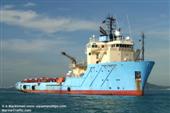 |
Maersk Promoter became the first anchor handling tug / supply vessel (AHTS), I worked on. It can be quite a different world from platform supply vessels (PSV),
since AHTS ships have a lot of equipment that PSVs don't. AHTS ships can deploy and retract anchors and complex mooring systems for oil rigs, carry out towing operations,
diving operations, under water work etc. The list is long! |
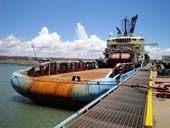 |
Part of the special equipment on an AHTS vessel compared to a PSV is the stern roller. This is basically a big cylinder, which can roll. This enables the ship to work
with wires and chain over the stern of the ship, and makes it possible to pull large oil rig anchors onto the deck etc. |
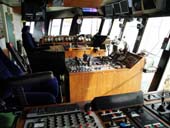 |
The aft bridge consoles on Maersk Promoter. Sitting here, you face aft and this is where the ship is manouvered whenever doing offshore work, using the main deck or on the final part of harbor approach when going alongside the wharf. This is also where the dynamic positioning equipment is located. Manouvering the ship from here is more comfortable and easier than on the forward bridge, since all the controls are closer together, plus you have a much better overview of the vessel. |
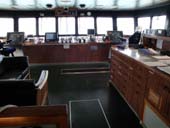 |
The forward bridge console. This is where the ship is steered during ocean passage and normal transit. The console in flanked by two radars with an electronic chart display in the middle. To the far right is the chart table/voyage planning station. |
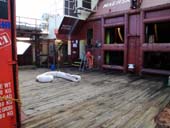 |
The forward part of the main deck, looking forwards. The white hook is a J-hook, which can be used to fish for anchor chains and -cables hanging in the water. This is done if you want to lift up the anchoring system, for example to pull it on deck and many other things. |
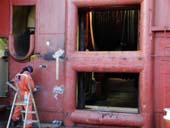 |
The repairman is prepairing to weld a stand for the J-hook as seen in the picture above. Through the holes to his right (called the crucifix) we can look into the winch garage at two of the ship's four work winch drums. On top a tow winch and below that an anchor handling winch. Both are fitted with 1000+ meters of 77 millimeter diameter steel wire rope (minimum breaking load about 400 tonnes). |
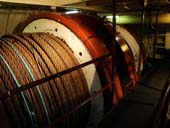 |
Inside the winch garage, looking at the two tow winch drums. 1000 meters of 77 mm wire weighs about 27 tonnes. Each winch drum can pull with a force of 350 tonnes, and when the brake is engaged can hold up to 500 tonnes. That's actually more than this particular 77 mm wire can withstand. |
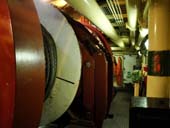 |
The bottom forward part of the winch garage, where the two anchor handling winches are located. The mechanism in the middle of the picture is the band brake for one of the winch drums. The winches are hydraulic, and in the top of the picture are the hydraulic oil pipes. |
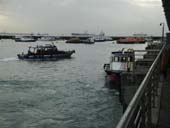 |
The Eastern Anchorage boat and launch terminal in Singapore, from where a small boat took me to the Maersk Promoter (visible in the middle of the picture) at the beginning of my first swing on board. |
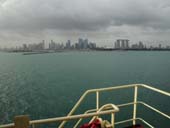 |
Singapore Skyline as seen from Maersk Promoter, looking in the direction of the boat and launch terminal. |
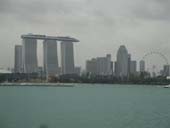 |
The Marina Bay Sands Hotel and Casino in Singapore, as seen from Eastern Anchorage in the Singapore Strait. That is one huge ferris wheel. |
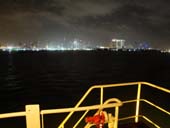 |
The Singapore Skyline makes for a pretty view at nighttime too. |
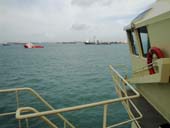 |
Singapore Eastern Working Anchorage is, just like all the other anchorages in the Singapore Strait, very busy and always full of ships from all over the world. |
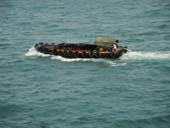 |
One of the many small work boats moving around the anchored ships, carrying out all thinkable jobs. I'm not aware what this particular one was doing. |
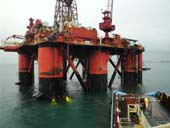 |
Shortly after I joined Maersk Promoter in late January 2011, we were chartered to tow the Semi-Submersible Drilling Platform "Nan Hai VI" from Keppel FELS Shipyard in Singapore to Exmouth, north western Australia. A journey from Singapore Strait over the Java Sea, through Lombok Strait past Bali and across the eastern Indian Ocean. A total of 1800 nautical miles. |
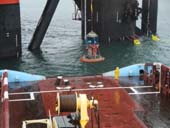 |
Transferring personnel via out deck onto small workboats, using the rig's crain and the so-called Billy Peug. We had to steady the ship right up to the rig in order for the crane to reach. |
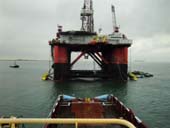 |
Moving in position in order to pick up the tow of the rig. The rig is towed in the tow bridle, which is connected to the ship's tow wire, which in turn is spooled on the tow winch drum. The tow bridle is a sort of "Y" which is part of the rig's equipment. |
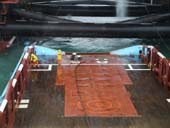 |
Having set up in position to receive the tow bridle from the rig, the ship's tow wire is visible, having been pulled down to the shark jaws, ready for connection to the tow bridle, once we get it on deck. The two are connected by means of a large shackle. The two pins sticking up are the guide pins, used to guide wires and chain in position aft of the shark jaws, making it possible to lock these around wire sockets and chain links, thus holding the system. |
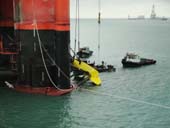 |
Work boats swarming around the hull of the rig, prepairing to let go a number of harbour tugs, which were holding the rig in position while we connected up the tow bridle. The yellow 16 tonne Stewpris anchors are seen bolstered, the rig being prepaired for transit. |
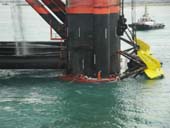 |
Each anchor ways 16 tonnes, and is deployed using an anchor handling tug like the Maersk Promoter. The ship simply "pulls out" the anchor to the desired location up to several miles away from the rig, and then lowers the anchor onto the seabed. This rig has 8 of these anchors, all of which are deployed when the rig is set up for offshore drilling. |
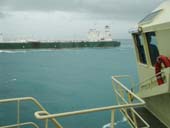 |
Having connected to the tow bridle, we set off through the Singapore Strait. The speed not yet built up, we were overtaken by numerous other ships, including this large oil tanker. Towing a rig through this heavy traffic area was quite interesting. |
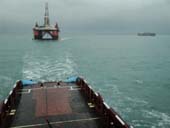 |
Here we have payed out some more tow wire, increasing the distance from us to the towed rig. The tow wire can be seen leading into the water. The faster you want to go, the more wire you need to pay out in order to avoid shock loads on the wire, which could break it. The outer guide pins are up in order to prevent the wire from creeping up onto the cargo railing. |
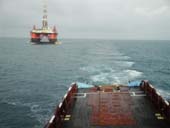 |
Having reached open sea, we payed out to a total of 900 meters of wire. In navigational terms we were now considered as one ship, over 1000 meters long. The rig had a tendency to go into the wind, meaning we dragged it along behind us in an angle, as is visible on this picture. In other conditions, the rig might also serpentine along behind the towing vessel. |
| Turn to next page >> |